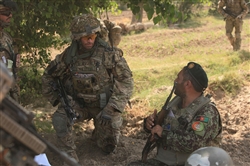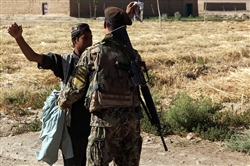Blog Posts tagged with "ballistic missile defense"
An Active Autumn Ahead
As we wrap up high summer, it's a sensible time to look ahead at the fall and think about the big tasks facing the NATO Alliance and US European Command. The Olympics and the Jubilee fade to memory, and hopefully most folks have managed to break away for a short vacation to recharge. The autumn will be a busy time.
From an Alliance perspective, we are very focused -- as you would expect -- on Afghanistan. That is really "job one," and will continue to absorb a great deal of our time and attention. Even given the setbacks, as I've often written over the past year the progress there, which continues, has been significant especially in the security sector.
We are transitioning to Afghan-led security in 75% of the country, and our plan to turn over complete control by the end of 2014 remains on track. Afghans now lead over 50% of the security operations, and we are partnered together on over 90% of them. In a recent and tragic Blackhawk helicopter crash, we lost both US SEALS and Afghan Commandos -- fallen heroes who fought together "shohna ba shohna", or shoulder-to-shoulder in Dari. There are 350,000 or so Afghan security forces, and they are taking casualties at about five times the rate of coalition soldiers. Their numbers and capability are rising. Our own casualty rates are down about 25% over last year, reflecting Afghans stepping to the lead.
Naturally, we are very concerned about another increasing negative trend: attacks by Afghan security forces on coalition forces. These have grown significantly compared to last year, and while statistically tiny (about 30) compared to the vast number of opportunities for such attacks given our work together (thousands of chances daily), they can have a negative impact on morale and perception out of proportion to their military impact. We're reviewing all our procedures carefully, vetting incoming Afghan security forces even more precisely, developing procedures to protect our troops, and using biometrics thoroughly.
This fall, the focus in Afghanistan will be on transition to Afghan led security, continuing to bring coalition combat forces down (US forces will drop to 68,000 shortly, from a high of well over 100,000), redeploying our equipment, training the Afghan security teams, and increasing combat capability in the east while consolidating significant gains in the south.
There will be good days and bad, but the overall trend is positive and we're on track to success. The key in the security sector will be maintaining mentoring, training, and funding for the Afghans through the transition.
Other operational tasks for NATO will be keeping peace in the Balkans (we still have 6,000 troops in Kosovo, which is tense but calm); continuing our strong progress against piracy (attacks have dropped in half compared to last year); improving our cyber defense capability (needs work); and further deployment of our missile defense system (radar in Turkey, AEGIS ships at sea, command and control in Ramstein, Germany). Busy, busy.
At the philosophical level, it is time to think about "NATO 3.0." I'll write more about this in the fall, but here is the idea: If we were a computer program, "NATO 1.0" was the Cold War -- massive, static, locked in a bipolar (and simple) struggle with the Soviet Union. "NATO 2.0" is what we have today -- globally deployed, heavily committed out of area, troops on three continents, a massive structure in Afghanistan. As we come out of Afghanistan in a couple of years, what does "NATO 3.0" look like? Stay tuned, as we shape it together.
Over at US European Command, we'll be working to support the nearly 10,000 troops we forward deploy to Afghanistan, consolidating base structure in Europe (continuing to reduce our footprint), devising rotational schemes to bolster our allies in the Baltics and Eastern Europe, working on the US parts of the NATO missile defense system, and focusing on our key relationships in Israel (part of the EUCOM remit for military-to-military contact), Poland, Turkey, and Russia -- where we seek zones of cooperation, recognizing we'll have differences in various areas.
EUCOM will also work on our key focus areas: international cooperation, interagency integration and private-public collaboration, and strategic communication. This all helps create what I've called elsewhere "open source security."
The wild card, of course, will be Syria and the Levant. The civil war in Syria continues to burn, with over 20,000 dead and perhaps a million pushed out of their homes. Lebanon is increasingly affected. Israel is deeply concerned, even as they continue to watch Iran. The Eastern Med is full of warships from lots of different nations. With struggling diplomatic efforts for Syria, there are increasing calls for military and humanitarian intervention.
Best,
Jim
Admiral James Stavridis
Commander, U.S. European Command and
Supreme Allied Commander Europe
Find more blog posts tagged with:
- International Security Assistance Force
- partnership
- anti-piracy
- Interagency
- public-private
- security
- Kosovo
- Balkans
- Afghanistan
- Force Posture
- strategic communication
- ballistic missile defense
- ISAF
- NATO
- open source
- cyber defense
- international affairs
- Mediterranean Sea
NATO: A Summer Agenda
As NATO finishes up the successful Chicago Summit and moves into the summer months, several key issues are bubbling.
Find more blog posts tagged with:
Commitment to 2014 and Beyond
As the North Atlantic Council finished up the 25th Summit it is clearly evident that it was a summit of commitment. The Alliance made the commitment to complete transition in Afghanistan and to support Afghans in achieving a stable future. It also made the commitment to ensuring NATO is capable of dealing with 21st century challenges, as well as the commitment to further strengthen connections with our global partners. Most importantly, the Chicago Summit demonstrated our commitment to each other - the unbreakable bond between North America and Europe, which remains the bedrock of our security.
Find more blog posts tagged with:
Sailing on to the NATO Chicago Summit
We've just concluded the two big warm-up events that have brought into focus what we'll be doing at the NATO Summit in mid-May, scheduled to be held in Chicago.
Find more blog posts tagged with:
NATO in 2011 – Five Key Events
As I look back on 2011, I think we had a reasonably good year in the operational sense. Lots of good “end of the year” retrospectives are appearing in various magazines and on-line sites, and I thought I’d chip in with my own top five operational moments for the Alliance this past year – and a hope that it stays at least relatively quiet between now and the end of the year.Stavridis
Find more blog posts tagged with:
Developing a True Strategic Partnership with Russia
My visit was part of NATO’s outreach and desire to develop a “true strategic partnership with Russia,” as it says in the Strategic Concept approved at the Lisbon Summit last fall. In my role as the Supreme Allied Commander, I continue to search for zones of cooperation with the Russian military.
Find more blog posts tagged with:
Dr. Strangelove Strikes Again!
Many of you know that we have a Notable Author and Film series at both my EUCOM and SHAPE headquarters, which allows us to routinely take a step back from our desk work and learn from some of the authors and artists who are observers, critics and practitioners of national security.
Find more blog posts tagged with:
Three Outcomes from Lisbon
We finished the Lisbon summit last week – really a high point thus far in the nearly 18 months I’ve been the Supreme Allied Commander Europe (SACEUR). While not without some challenges, overall the summit must be judged a real success.
Find more blog posts tagged with:
Off to Lisbon!
Currently, 28 NATO Heads of States and Governments (HoSG) are expected to convene at the NATO Summit. Over a series of meetings, our leaders will discuss a handful of issues central to the future security of Europe and North America, focusing on the new strategic concept and its subsequent implementation: crisis management; missile defense; the comprehensive approach; cyber security; and NATO headquarters and command structure reform.
Find more blog posts tagged with:
The Road Ahead
I had an experience last week I never expected when I began my naval career in the 1970s during the Cold War period: a four-day visit to Moscow and St. Petersburg, hosted by the Russian Chief of Defense.
Find more blog posts tagged with:
A Week on Capitol Hill
As I told you in my last blog, I spent this past week on Capitol Hill. I testified before the Senate Armed Services Committee (SASC), the House Armed Services Committee (HASC) and the House Appropriations Subcommittee on Military Construction (HAC MILCON).


Comments: 1
May NATO 3.0 witness a full-scale commitment to Peace Through Development that makes the deserts bloom by means of a vast expansion of and priority on what a joint service Corps of Engineers might do for those living in deprivation and facing austerity. Might that the creation of credit serve that purpose [Let there be money is all really stands behind the dollar anyway] such that all the pain and suffering that has been endured on all sides finally finds us beating our swords into plowshares.